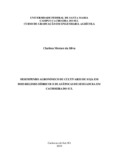| dc.contributor.advisor | Oliveira, Zanandra Boff de | |
| dc.creator | Silva, Clarissa Moraes da | |
| dc.date.accessioned | 2019-12-19T16:19:23Z | |
| dc.date.available | 2019-12-19T16:19:23Z | |
| dc.date.issued | 2019-07-12 | |
| dc.date.submitted | 2019 | |
| dc.identifier.uri | http://repositorio.ufsm.br/handle/1/19195 | |
| dc.description.abstract | The objective of this study was to analyze the development and productivity of three cultivars of soybean in two sowing seasons using two different water regimes in the municipality of Cachoeira do Sul - RS. There were performed two field experiments in the experimental area of UERGS, in two different sowing seasons: 11/21/2018 (conventional crop) and 01/11/2019 (short crop). The experimental design used was in bands whit 4 replications, in a factorial scheme (2x3). The factor A was constituted in two hydric regimes: irrigated and not irrigated; and the factor B was constituted by three different soybean cultivars: NS 4823, NA 5909 and NS 6909. The income components were analyzed by: number of pods per plant-1; number of grains per pod-1; weight of a thousand grains (PMG) and grain yield (kg ha-1). The additional irrigation of 134.5 mm held in the conventional crop has increased the IAF of the plants in 18%, the PMG in 5.5% and the yield in 7.5%. While in the short crop, the additional irrigation hasn’t brought any benefits to the yield components or to the grain components. The short crop sowing has resulted in a medium shortening of 15 days on the cycle of development of cultivars. In the conventional crop and in the short crop, the cultivar NS 4823 has presented intermediate values in all components of income and resulting in bigger grain yields of 4852.7 and 1919.6 kg ha-1 respectively. The sowing at the preferential season (conventional crop) for the municipality of Cachoeira do Sul has resulted in better agronomic indicators for the culture of soybean, independent of the hydric regime used or the cultivar chosen. | eng |
| dc.language | por | por |
| dc.publisher | Universidade Federal de Santa Maria | por |
| dc.rights | Acesso Aberto | por |
| dc.subject | Irrigação | por |
| dc.subject | Rendimento | por |
| dc.subject | Soja | por |
| dc.subject | Irrigation | eng |
| dc.subject | Income | eng |
| dc.subject | Soybean | eng |
| dc.title | Desempenho agronômico de cultivares de soja em dois regimes hídricos e duas épocas de semeadura em Cachoeira do Sul | por |
| dc.title.alternative | Agronomic performance of soybean cultivars in two different water regimes and two sowing seasons in Cachoeira do Sul | eng |
| dc.type | Trabalho de Conclusão de Curso de Graduação | por |
| dc.degree.local | Cachoeira do Sul, RS, Brasil. | por |
| dc.degree.graduation | Bacharelado em Engenharia Agrícola | por |
| dc.description.resumo | O objetivo deste estudo foi analisar o desenvolvimento e produtividade de três cultivares de soja em duas épocas de semeadura utilizando dois regimes hídricos no município de Cachoeira do Sul – RS. Foram realizados dois experimentos de campo na área experimental da UERGS, em duas épocas de semeadura: 21/11/2018 (safra) e 11/01/2019 (safrinha). O delineamento experimental utilizado foi em faixas com 4 repetições, em esquema fatorial (2x3). O fator A constituiu em dois regimes hídricos: irrigado e não irrigado; e o fator B foi constituído de três cultivares de soja: NS 4823, NA 5909 e NS 6909. Analisou-se os componentes do rendimento, por meio do: número de vagens planta -1; número de grãos vagem-1; peso de mil grãos (PMG) e rendimento de grãos (kg ha-1). A irrigação suplementar de 134,5 mm realizada na safra, incrementou em aproximadamente 18% o IAF das plantas, em 5,2% o PMG e 7,5% o rendimento. Enquanto que na safrinha, a irrigação suplementar não trouxe benefícios aos componentes do rendimento e no rendimento de grãos. A semeadura de safrinha resultou em um encurtamento médio de 15 dias no ciclo de desenvolvimento das três cultivares. Na safra e safrinha, a cultivar NS 4823 apresentou valores intermediários em todos os componentes do rendimento resultando em maiores rendimentos de grãos de 4852,7 e 1919,6 kg ha-1 respectivamente. A semeadura na época preferencial (safra) para Cachoeira do Sul resultou em melhores indicadores agronômicos para a cultura da soja, independente do regime hídrico utilizado e da cultivar escolhida. | por |
| dc.publisher.country | Brasil | por |
| dc.publisher.initials | UFSM | por |
| dc.subject.cnpq | CNPQ::CIENCIAS AGRARIAS::ENGENHARIA AGRICOLA | por |
| dc.publisher.unidade | UFSM Cachoeira do Sul | por |


